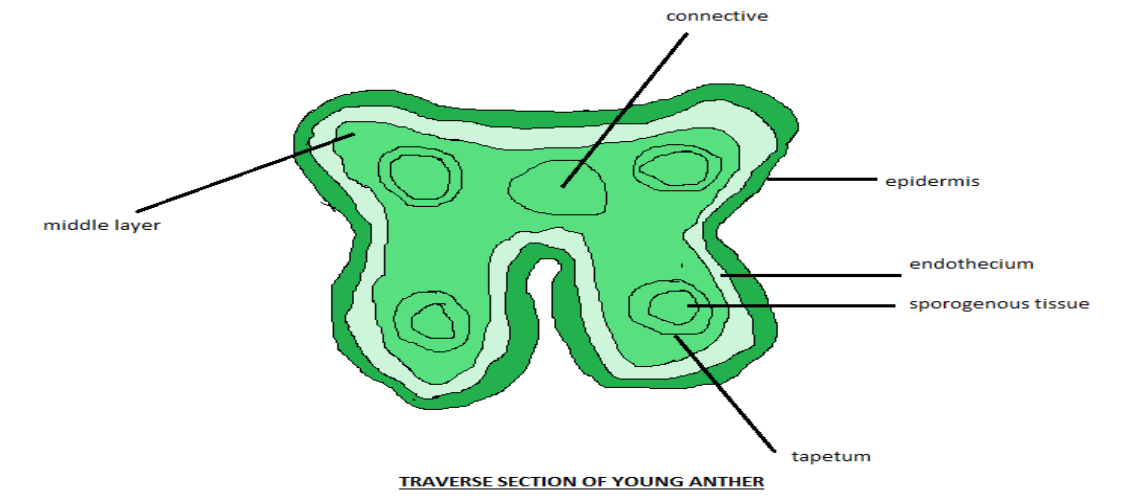
Draw a neat labelled diagram of T.S of young anther.
Answer
572.4k+ views
Hint: Anther has a four-sided structure that consists of four microsporangia located at each lobe. Anther produces pollen and it is the integral part of the flower’s structure.
Complete step by step answer:
T.S of young anther
It is a four-sided, multicellular structure. A young anther has a homogenous mass of hypodermal cells that is surrounded by a layer of epidermis.
In each corner, develop one or more archesporial initials.
These initials then divide by a periclinal wall into outer primary parietal cell and inner primary sporogenous cell.
Primary parietal cell divides periclinally as well as anticlinally and they form 3 to 5 concentric layers of the cells.
Anther consists of microsporangia and each microsporangia contains a layer of epidermal cells
Below the epidermal layer, endothecium exists that is radially elongated.
The innermost layer of the cell is called a tapetum. Tapetum is very nutritive in function. It lies below the middle layers. These middle layers are the flattened and crushed parenchymatous cells.
Pollen grains develop from the sporogenous tissue.
Some cells form from the procambial strand in the centre of anther.

Note:
Tapetum is the innermost layer that lies in anther. It helps in supplying nutrition and enzymes that are required for pollen maturation. It is a source of precursor for pollen coat. Parenchymatous cells which are the middle layer help in the storage, photosynthesis and gaseous exchange in the plants.
Complete step by step answer:
T.S of young anther
It is a four-sided, multicellular structure. A young anther has a homogenous mass of hypodermal cells that is surrounded by a layer of epidermis.
In each corner, develop one or more archesporial initials.
These initials then divide by a periclinal wall into outer primary parietal cell and inner primary sporogenous cell.
Primary parietal cell divides periclinally as well as anticlinally and they form 3 to 5 concentric layers of the cells.
Anther consists of microsporangia and each microsporangia contains a layer of epidermal cells
Below the epidermal layer, endothecium exists that is radially elongated.
The innermost layer of the cell is called a tapetum. Tapetum is very nutritive in function. It lies below the middle layers. These middle layers are the flattened and crushed parenchymatous cells.
Pollen grains develop from the sporogenous tissue.
Some cells form from the procambial strand in the centre of anther.

Note:
Tapetum is the innermost layer that lies in anther. It helps in supplying nutrition and enzymes that are required for pollen maturation. It is a source of precursor for pollen coat. Parenchymatous cells which are the middle layer help in the storage, photosynthesis and gaseous exchange in the plants.
Recently Updated Pages
Master Class 12 Business Studies: Engaging Questions & Answers for Success

Master Class 12 Economics: Engaging Questions & Answers for Success

Master Class 12 English: Engaging Questions & Answers for Success

Master Class 12 Maths: Engaging Questions & Answers for Success

Master Class 12 Social Science: Engaging Questions & Answers for Success

Master Class 12 Chemistry: Engaging Questions & Answers for Success

Trending doubts
What is meant by exothermic and endothermic reactions class 11 chemistry CBSE

Which animal has three hearts class 11 biology CBSE

10 examples of friction in our daily life

One Metric ton is equal to kg A 10000 B 1000 C 100 class 11 physics CBSE

1 Quintal is equal to a 110 kg b 10 kg c 100kg d 1000 class 11 physics CBSE

Difference Between Prokaryotic Cells and Eukaryotic Cells




